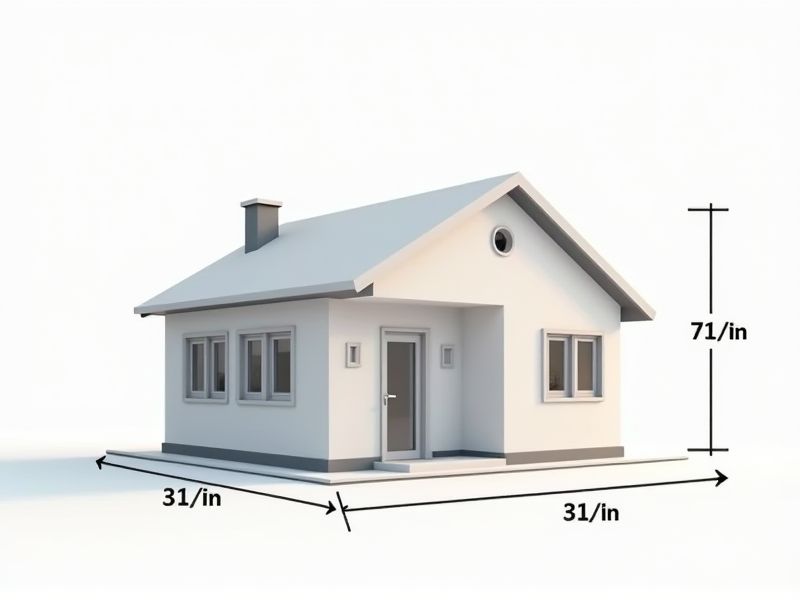
Modular homes are built using standardized dimensions to streamline manufacturing and ensure compatibility with transportation regulations. Typically, the modules are constructed in widths of 12, 14, or 16 feet, and lengths often range from 40 to 76 feet per section. Most homes consist of multiple sections joined together on-site, so final sizes can vary, but common total finished home sizes are 1,000 to 3,000 square feet. Before making decisions, check your local building codes, as regulations and transportation limitations can impact which modular home sizes are available in your area.
Width
Modular homes typically range in width from 12 to 36 feet, accommodating various design preferences and site requirements. The most common widths of single-section modular homes are 14 to 16 feet, while multi-section homes often span 28 to 36 feet. This width flexibility allows for a balance of interior space and exterior aesthetic, meeting diverse buyer needs. When choosing your modular home, consider how the width impacts room layouts, overall livability, and site limitations.
Length
Modular homes typically range in length from 20 to 100 feet, accommodating various family sizes and lifestyle needs. Many manufacturers offer customization options, allowing you to select dimensions that fit your specific plot of land. The length impacts not only the overall aesthetics but also the interior space available for living areas, bedrooms, and bathrooms. Larger models often provide more open floor plans and greater design flexibility, appealing to those seeking spacious living environments.
Height
Modular homes typically have a height ranging from 8 to 12 feet for each module, allowing for versatile design layouts and functional use of space. This height accommodates standard ceiling requirements while facilitating efficient ventilation and natural light. Depending on local building codes, the total height of a modular home, including the roof, can reach up to 35 feet, providing options for additional stories or lofts. When planning your modular home, consider how the height will impact aesthetics, energy efficiency, and overall comfort.
Room Size
Modular homes typically feature room sizes ranging from 8 to 16 feet in width and 10 to 12 feet in height, ensuring spacious living areas while maintaining efficient use of space. Bedrooms often measure between 10 by 12 feet and 14 by 16 feet, accommodating various furniture arrangements and providing comfort. Common areas, such as living rooms and kitchens, can range from 200 to 400 square feet, allowing for open floor plans and flexibility in design. By focusing on optimal room sizes, modular homes offer practical living solutions without sacrificing style or functionality.
Wall Thickness
The standard wall thickness for modular homes typically ranges from 2x4 to 2x6 inches, affecting insulation efficiency and overall energy performance. A 2x4 wall provides adequate insulation for temperate climates, while a 2x6 wall significantly enhances thermal resistance, often yielding R-values between 19 and 21. You can expect higher durability and noise reduction with thicker walls, which may also improve your home's market value. It's essential to consider local building codes and energy requirements when selecting the appropriate wall thickness for your modular home.
Window Dimensions
Modular homes typically feature windows with standard dimensions that enhance energy efficiency and natural light. Common sizes include double-hung windows measuring 24 inches by 36 inches, which are popular for their ease of use and ventilation. Sliding glass doors often measure 72 inches by 80 inches, providing expansive views and access to outdoor spaces. When designing your modular home, consider these dimensions to optimize both aesthetics and functionality while maintaining compliance with building codes.
Door Dimensions
Modular homes typically adhere to standard door dimensions to ensure compatibility and ease of installation. The most common interior door size is 32 inches wide by 80 inches tall, suitable for most rooms, while exterior doors generally measure 36 inches wide by 80 inches tall. These dimensions facilitate access, allowing for smooth movement of furniture and appliances into your home. Custom door sizes are available, but opting for standard dimensions can save you approximately 10-15% on overall construction costs.
Ceiling Height
Modular homes typically feature a standard ceiling height of 8 feet, which can enhance the spacious feel of living areas. Customization options often allow for increased ceiling heights, such as 9 or 10 feet, providing additional aesthetic appeal and a more open atmosphere. A higher ceiling can improve natural light distribution, enhancing the overall ambiance of your home. When selecting a modular home, consider how ceiling height impacts spatial perception and your personal comfort.
Roof Pitch
The standard roof pitch for modular homes typically ranges from 4:12 to 8:12, which means for every 12 horizontal inches, the roof rises between 4 to 8 vertical inches. This pitch not only enhances the aesthetic appeal but also contributes to effective water drainage and snow removal, crucial in regions with heavy precipitation or snowfall. Roof pitches within this range provide sufficient attic ventilation, which can improve energy efficiency and extend the lifespan of roofing materials. You can select from various roofing options, including asphalt shingles, metal, or tile, to match your home's architectural style and local climate conditions.
Foundation Requirements
Modular homes typically require a foundation that meets specific engineering standards to ensure structural integrity and longevity, often involving a concrete slab, crawl space, or full basement. The International Building Code (IBC) outlines these foundational requirements, which may vary by region, recommending local soil inspection and load-bearing assessments. To optimize energy efficiency and moisture control, a properly insulated foundation is crucial, with many builders adhering to enhanced guidelines for thermal performance. It is vital that your modular home's foundation is built to code, as this directly impacts its durability and compliance with local zoning laws.
